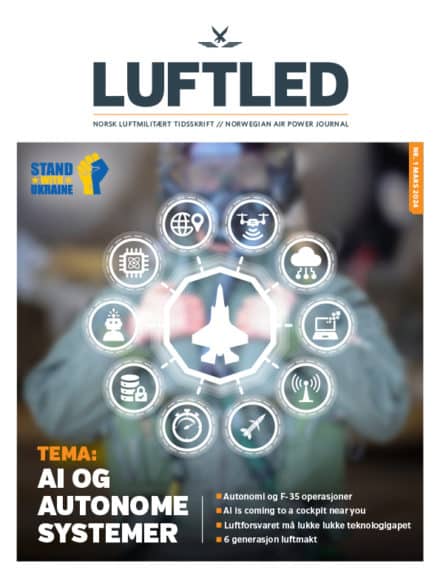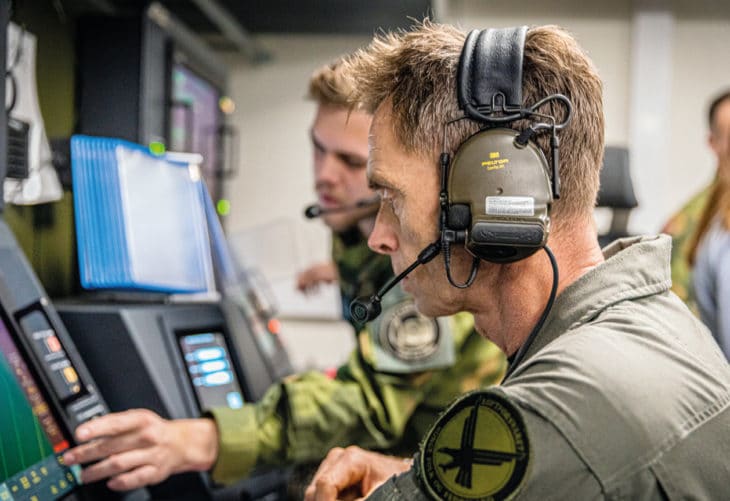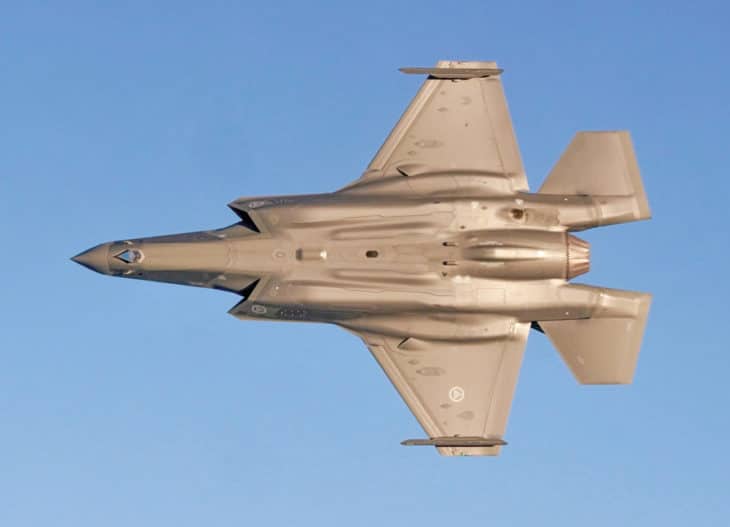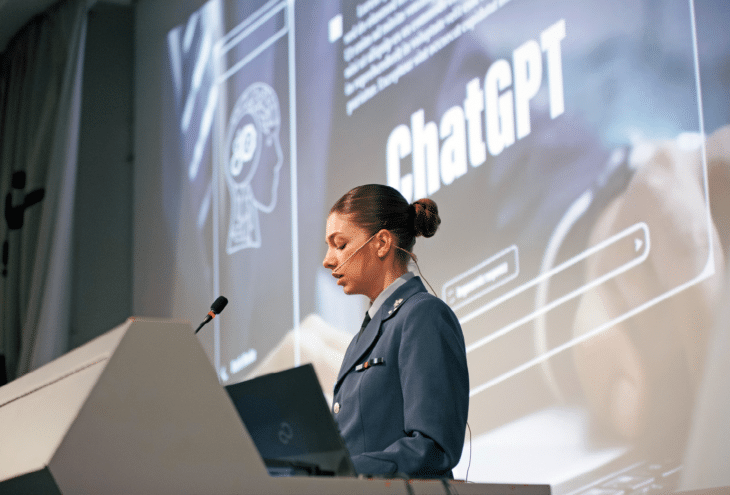Autonomy and AI: The future of Norway’s defense
Norway’s armed forces are historically small in number, yet this highly professional force has transformed in recent years to perform myriad twenty-first-century missions that are unique to the nation. As a NATO member, it must defend Europe’s longest coastline, patrol the skies over the stormy and strategically vital North Atlantic, and maintain a small but economically and culturally vital border with Russia.

It must also jointly protect Arctic interests such as Svalbard and natural ocean resources, in addition to assuring cyber and electronic infrastructure. It also has a fresh mandate to reimagine defense cooperation with new Scandinavian NATO allies Sweden and Finland. The challenge for Norway today involves countering growing numbers of potential asymmetric threats in each of these areas posed by the new technologies changing warfare, while traditional military threats requiring highly capable conventional forces have not gone away. Furthermore, Russia’s military failures in Ukraine are no guarantee that future operations will not succeed or at least be catastrophically harmful to Norway. Russia will certainly reform its military after the war in Ukraine. Moscow will likely address many of the operational shortcomings exposed by the conflict and may even accelerate their technological transformation. It is tempting to assess Norway’s current and future military by its budget or the number of active-duty troops or squadrons of fighter jets. After all, the force is half the size it was at the end of the Cold War. Yet spending has more than doubled since then to reach historical highs as the force has incorporated more technology. It is unlikely that Norway’s military will grow in end strength to past peaks, which therefore requires a fresh way of thinking about military strength and the role that technology can play in it. Moreover, Norway’s growing population of ageing citizens may pose challenges to filling the ranks of the armed forces.
Norway’s opportunity
Recent advancements in robotics, software, satellites, and autonomy place a new onus on Norway’s leaders to carefully consider the technological possibilities in areas such as robotic systems capable of supplanting human forces, powerful individual weapons to target aircraft and armored vehicles, and lower-cost commercial geospatial data. Technological asymmetries can be turned into advantages with the right policies and investment. As such, this review offers an opportunity to consider how the above challenges can be addressed with investment in new technological capabilities that link to current and near-future warfare trends. It reflects observations from the conflict in Ukraine, such as:
- Commercial space is vital for situational awareness and communications.
- Defending civilians requires hard power because laws and norms are insufficient.
- Mobile phones and AI create new battlefield transparency and cognitive effects.
- Civilian expertise in AI, drones, and software is central to tactical operations.
Norway must also contend with more than the threat of Russia. As NATO asserted at its Madrid Summit in 2022: “We face systemic competition from those, including the People’s Republic of China, who challenge our interests, security, and values and seek to undermine the rules-based international order.” Irrespective of recent public tension between Beijing and Moscow, China’s military interoperability with Russia continues to expand, particularly in the Arctic. China’s growing defense-industrial capabilities, particularly in autonomy, hypersonic missiles, offensive space capabilities, and advanced shipbuilding portend Russia-like consideration of Beijing’s strategic interests and how military presence, if not force, may be used. Norway’s military posture today also embodies a useful tension between high-tech platforms and traditional defense. Fifth-generation F-35 fighters patrol Arctic skies flying tens of thousands of feet over small-unit, long-range reconnaissance foot patrols along the Russian-Norway border. This is a useful paradigm for understanding how emergent technologies can contribute to Norway’s security, but not at the expense of common sense or overreliance on vulnerable systems. The following concepts reflect this realistic understanding of what is not only technologically possible, but politically or culturally feasible. At the same time, it should be clear that some of the ideas offer a path that will lead to clear departures from traditional ways of thinking about the Norwegian military and how it employs technology. It would be easy to discount the concepts discussed as too radical. Even with that categorical reaction, it is worth considering the rationale behind them because they address underlying truths that future conflict will be waged at machine speed, with increasing autonomy, and involve greater peril to civilian populations from cognitive and kinetic effects.
Norway’s solutions
Thinking clearly about the future of warfare and technology’s role in it requires imagination. Yet such thinking must also remain anchored to a central line of questioning. In this case, the crucial questions focus on threats, priorities, and operations:
- What technology areas will create new or amplify existing threats to such an extent that they will affect the defense sector in the next ten to twenty years?
- What technology areas should the defense sector emphasize in order to avoid weakened defence capabilities in relation to Russia in the next ten to twenty years?
- What types of technology should the defense sector use to maximize interoperability with allies and partners for the next ten to twenty years?
These questions lead to the conclusion that, to prevail in a high- or mixed-intensity war with Russia over the next two decades, Norway should invest in next-generation situational awareness and targeting, as well as seek-and-destroy weapons systems capable of semi- or fully autonomous target selection. As an example, traditional mechanized armored forces are still vital to domestic and foreign military operations. Yet the introduction of Sweden and Finland as NATO members allows for a reconsideration of how Norway should defend Finnmark at a time when heavy armored vehicles are increasingly vulnerable to both long- and close-range weapons systems. Instead, small, fast-moving, lightly armored units equipped with short- and medium-range strike weapons like rocket artillery, as well as organic anti-air and anti-drone defense systems, can have the same or greater destructive capability at greater range, but with less exposure to Russian artillery or long-range missiles fired from within Russian territory than traditional units. In the air, fifth-generation fighters like the F-35 will jointly defend Scandinavian airspace with the aid of autonomous unmanned fighter and ground attack aircraft, while providing crucial data and sensing capabilities to ground and maritime forces. Norway’s naval forces will necessarily operate with squadrons of distributed manned and unmanned squadrons for surface and undersea missions given the growing lethality of Russian and Chinese anti-ship missiles. As part of a renewed Scandinavian defense, Norway could become a regional or European leader in such autonomous and human-machine teamed systems by partnering with US and other allied software, sensors, and robotics programs. This would represent a new specialization for the Forsvaret of the late 2020s and 2030s and complement Swedish and Finnish capabilities.
Future threats
What technology areas will create new or amplify existing threats to such an extent that they will affect the defense sector in the next ten to twenty years? There is a long list of military-oriented or specific defense technologies that will have a significant impact on the threat environment Norway faces. Some, such as synthetic biology or quantum computing, have the potential to be truly game-changing in the near future. Yet the following three military technology threats that fuse next-generation software, AI, and breakthrough hardware are already extremely consequential, whether Russia or another nation employs them:
- Space-based surveillance, communications, and offensive systems;
- Inexpensive autonomous armed drones and unmanned ground systems; and
- Smartphones and AI-personalized cognitive and kinetic warfare.
Space data
This is a new era for commercial space-based data from small satellites that has major implications for future warfare. Precise and accurate information about imagery on Earth is now accessible and relatively affordable due to a new generation of inexpensive and ultimately disposable satellites. At the same time, advances in AI make processing this new wave of data much faster and more reliable. Recently, space-based surveillance has proven extremely effective for the Ukrainian military for establishing situational awareness and targeting their operations against Russian forces. Norway’s sensitive maritime oil and gas resources and infrastructure are likely one such target of persistent space-based surveillance. This space-based approach is also part of a solution to protecting those same commercial assets. The emerging market for data from space will make hiding—and defending—much more difficult in the 2020s and 2030s, as will small satellite constellations owned by nation states. As precision weapons like rocket artillery and armed drones proliferate, the ability to locate targets from space will become increasingly important, particularly in contested airspace. With communications, the Starlink space-based internet connectivity platform shows the military effectiveness of small satellite alternatives to terrestrial networks during wartime. For Norway, this is both risk and opportunity. Defensive fortifications or movement of material, for example, will be detected immediately. At the same time, purchased satellite data offers near real-time access to information on Russian preparations and movement.
Robotic autonomy
The past three years revealed a growing profile for drones in warfare, from the 2020 Armenia-Azerbaijan conflict to Ukraine’s present battlefields, even with the rudimentary level of control and semi-autonomy that exists today. Small and inexpensive drones can now be equipped with AI-powered target-recognition systems, as well. As drones move from surveillance roles to regularly attacking targets, this will only grow and evolve tactics. Russia’s experience in Ukraine with drones shows a willingness to regularly employ them in warfare, and its import of foreign-made drones such as Iran’s indicates Moscow will continue employing armed drones. Many nations are proliferating drone systems, including China as a leading exporter.
Technological asymmetries can be turned into advantages with the right policies and investment
Meanwhile, Ukraine’s crowd-sourced and civilian-driven drone innovation shows a new leading technological edge, while its military flies Turkey’s TB2 drone that can operate largely autonomously. A mix of heterogenous robotic capabilities will be a staple of future conflicts. Armed ground systems are poised to emerge onto battlefields, as well, in a replication of the aerial drone evolution. The Nord Stream 1 and 2 pipeline explosions point to the sort of high-consequence strategic economic attack that an undersea robotic system might carry out in the future with greater autonomy and therefore stealth. The significant shift ahead will involve systems operating without that control stations and high-bandwidth communications that are necessary today. To that end, NATO is reportedly preparing a strategy for the responsible use of autonomy, in another recognition of evolving robotic systems. Even if NATO members adhere to such guidelines, it is unclear whether states such as Russia or China will do so even as they develop and employ autonomous weapons systems.
Smartphones and AI
Smartphones are ubiquitous on twenty-first-century battlefields, but their use has evolved during the past few years, leading to new tactical and strategic implications. There is a developing fusion of AI-powered image processing, scaling information, and cognitive campaigns using social media, and ever-more refined kinetic and electronic targeting capabilities homing in on mobile devices. Just as space-based surveillance creates new levels of operational transparency, the proliferation of high-quality smartphone cameras linked to cloud computing means that as soon as information is identified with a handheld device it can be shared across civilian or military networks, not just social media. In a recent example, Ukraine’s software developers have created apps that can alert citizens in real-time to air raids, while the government’s eVorog chat program enables registered users to rapidly report Russian equipment or personnel, data which is screened by AI. Just as smartphones are sensors, they are vectors of information—and disinformation. The contest to capture an individual’s attention and influence their emotional state or real-world actions is in effect an evolution toward cognitive warfare, which could see the precision targeting of individuals at scale using new AI systems. Among those systems are text-generating tools called large language models, which have the ability to churn out an unending stream of realistic, human-like writing on social media and elsewhere. The open-source LLM Bloom features forty-six languages and thirteen programming languages. Image generation and manipulation tools using AI are also proliferating as easy-to-use programs, with social media consumer apps offering a preview. In Ukraine, deep fakes quickly emerged in the conflict with a spoofed video of Ukrainian President Volodymyr Zelensky ordering Ukrainian forces to stand down.Both of these software capabilities will increasingly be managed by AI programs themselves, a form of autonomy that is going to influence everything from propaganda to civil discourse during conflict.
Priorities and interoperability
What technology areas should the defense sector emphasize in order to avoid weakened defense capabilities in relation to Russia over the next ten to twenty years and how might they reinforce interoperability with allies and partners? The other side of risk from technologies changing warfare is opportunity. The same inventions and innovation that exacerbate current and future threats to Norway also indicate where to focus research and investment. This requires consideration of Russian military capability and investment plans, as well as a realistic assessment of their effective execution over the next two decades. Caution is needed, however, in assuming the failures of Russian forces in Ukraine will contribute to the failings of late 2020s and 2030s Russian military forces. While military reform of the past five years in Russia has proven to be hollow, it is also possible that the same mistakes will not be made again. Either way, there are enduring aspects to the threat Russia poses to Norwegian territory and Norwegian forces operating abroad in support of NATO: threatening Arctic and North Sea lines of communication (including Svalbard), air-defense denial zones over Scandinavia, seizing and holding territory in Finnmark through massed armor, medium- and long-range precision and area weapons fired from inside Russia, as well as cyberattacks and “gray zone” operations. Each of the following priorities addresses these threats:
- Autonomous aerial, maritime, and ground systems for rural or open territory (surveillance, logistics, attack);
- Small unit anti-armor, anti-ship, and anti-air: Javelin in every closet; and
- Commercial space access and support
Autonomy 3.0
In the era of software-driven warfare, the ability to mass large numbers of forces still rings true—even if it strikes a different note. Advances in robotics and AI-powered autonomous systems will enable nations to mass forces differently than in the past, and in ways that are difficult for conventional defenses to counter. It also opens new avenues for defense. Today’s swarm-capable munitions like the Naval Strike Missile already show the potential of such systems and preview how they might develop. Consider that Norwegian military forces must cover over 385,000 square kilometers of territory and more than 25,000 kilometers of coastline. Using unmanned and largely autonomous systems to patrol Norwegian territory would allow for the judicious use of manned platforms such as F-35 fighters or Norway’s six Skjold-class missile ships. Many strategic areas in Arctic Scandinavia, such as Cap of the North where Finland, Norway, and Sweden share interests and territory, are sparsely populated yet constitute significant land and maritime portions of each country. With traditional mechanized forces, such an area is difficult to patrol, let alone defend. Using more numerous autonomous air, ground, and sea systems for joint or unilateral patrolling, logistics support, and deterrence would allow for extending that presence beyond what has been traditionally possible. Take the example of Norwegian military patrols on oil and gas infrastructure in the wake of the Nord Stream pipeline attacks: this presents a resource challenge to the Forsvaret if this mission becomes an enduring one. Such persistent surveillance and interdiction missions are well suited to autonomous maritime and air systems whose data is collected and sorted by AI onboard or on the ground. Yet current unmanned aerial systems (UAS) spending in the air domain, for example, is less than 1 percent of 2021-2028 Norwegian Defense Ministry forecasts, and land domain spending for UAS is under 5 percent. Similar explorations of operational trade-offs are underway with the US Marine Corps Force Design 2030 reforms. By giving up main battle tanks and some fighter aircraft, the Marine Corps seeks to reinvest those resources in smaller units of infantry supported by robotic and autonomous systems whose military capabilities are on par with the conventional weapons they replace. Moreover, it will allow Marines to operate near China, often without direct support from conventional US military resources, and deploy a new generation of unmanned platforms, such as the NMESIS robotic wheeled vehicle armed with Naval Strike Missiles or the Metal Shark autonomous ship armed with loitering munitions. One of the abiding defensive challenges is how to protect Finnmark and southern Norway from a Russian incursion in the north. In the case of such a scenario, a Brigade North defensive line in or south of Finnmark could be reinforced and patrolled with autonomous ground and air vehicles, which could be armed and tasked with deterring or interdicting Russian forces. Similarly, an ongoing challenge of regional resupply to Finnmark during wartime could be addressed with the new generation of autonomous cargo aircraft. Similar tactics could be used with unmanned maritime surface and undersea systems along Norway’s extensive coastline for patrol and supply. Because such autonomous robotic platforms’ software can train in AI-powered synthetic environments, they can be readied for wartime use without requiring as much real-world training. They also allow for reconsidering the composition of land units, such as the Norwegian Army’s Brigade North. Acknowledging the break with traditional conceptions of military force and the attendant operational ethics issues of weaponized autonomy, a shift by the Norwegian military to employ autonomous robotic systems compensating for its end strength would allow for a novel way to counter massed (or dispersed) Russian ground forces with less risk and greater precision. However, robotic systems have their own logistical challenges and operational limits. Yet there is existing software and robotics expertise in Norwegian society, which could be developed as a national resource of expertise in developing robotics for austere environments. The likely growing use of autonomous weapons systems by Russia and China necessitates ensuring those nations will not take a lead that will be difficult to close operationally—or ethically.
Conclusion
These are vital questions considering how new technologies could be used to reimagine the defense of Norway, as well as support Forsvaret’s operations abroad. Russia may be the near-term focus, but these explorations are also applicable to other strategically important areas, such as the growing importance of Arctic trade routes to nations like China. Allies and partners are essential, not just operationally in the defense of Norway but in how the nation prepares for the unthinkable. There are also lessons to be drawn elsewhere regarding technology and transformation, such as the Force Design 2030 reform of the United States Marine Corps, and emerging concepts around the civilian-military composition of combat units using new capabilities like drones. The war in Ukraine offers myriad hard-won lessons, too, but it is important to remember that Russia in 2022 will be different than the Russia of 2032 or 2042. For all the focus on technology and the questions about the future of Norway’s defense, it is impossible to understand, and prepare for, the kinds of technologies that will shape future conflicts without remaining focused on the human experience of twenty-first century warfare.





